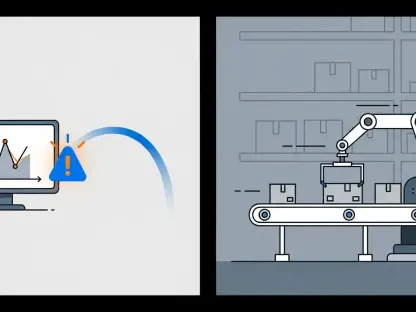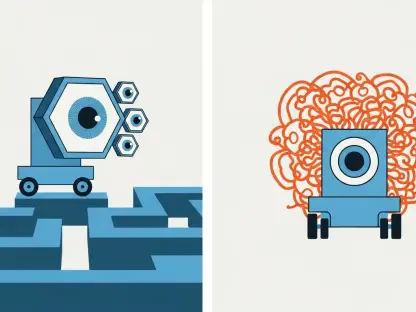The introduction of GPT-4.1 by OpenAI has brought a transformative wave across the field of artificial intelligence, capturing attention worldwide. As the demands for more sophisticated AI models surge, this release serves as a pivotal moment that redefines the capabilities of machine learning and AI systems. The technology not only enhances efficiency and accuracy in coding but also addresses complex web tasks with impressive precision. This analysis delves into GPT-4.1’s role in shaping AI’s landscape, evaluating its growth, adoption, and impacts across diverse sectors.
Growth and Adoption of GPT-4.1
Current Data and Trends
GPT-4.1’s impact is underscored through remarkable growth and widespread adoption. According to industry data, the model has been implemented by thousands of businesses worldwide who aim to harness AI’s full potential. Notably, GPT-4.1’s powerful coding capabilities, which achieved a 54.6% accuracy on SWE-bench Verified, represent a significant enhancement over its predecessor, GPT-4o. This leap underscores not just an improvement but a massive jump in precision, which draws substantial attention from various sectors eager to integrate AI into more challenging tasks. As enterprises recognize its potential, the traction momentum continues to gather pace, entrenching GPT-4.1 as an invaluable asset.
Reports from credible AI research hubs further indicate that the model’s adoption is accelerating across the industry. Results showcase that companies leveraging GPT-4.1 experience not only increased performance output but also demonstrate enhanced procedural adherence. This reflects a growing influence of the model in both large-scale enterprises and SMEs, highlighting how current trends favor advanced AI-driven strategies to optimize operations and resolve industry-specific challenges.
Real-world Applications
Real-world use cases and applications of GPT-4.1 exemplify its versatility and effectiveness. For instance, renowned tech companies integrate GPT-4.1 within their ecosystems to improve software development processes. The model is employed to enhance coding accuracy, streamline content generation, and automate support systems—each benefiting from its complex task-handling ability. Notable implementations extend to industries such as finance, where automated advisory services are enhanced through intelligent data processing and analysis facilitated by the model.
Case studies further illustrate GPT-4.1’s significant impact on product development and innovation. Some of the leading players in AI tech, like automotive industries, utilize GPT-4.1 for design and modeling tasks, drastically reducing development cycles. This transformative approach allows these companies to remain competitive by ensuring faster turnarounds on innovative solutions and enhanced consumer experiences, setting a new benchmark for AI application in product innovation.
Expert Insights and Analysis
As GPT-4.1 continues to shape AI development, expert insights provide critical perspectives on its evolution and future implications. Industry leaders recognize its role as not just an upgrade but a revolutionary leap in machine intelligence. Experts highlight that the model addresses major industry challenges, such as tedious manual coding processes and lack of contextual thesaurus-driven automation in AI, which has often posed a bottleneck.
There is a consensus among thought leaders in the field that the deployment of GPT-4.1 brings numerous advantages, including strengthened safety protocols and transparency models, like OpenAI’s Safety Evaluations Hub. Yet challenges remain, such as ensuring ethical use and managing scaling to avoid potential biases. These challenges demand ongoing dialogue and adaptive strategies, ensuring technology aligns with societal values while maximizing its potential.
Future Prospects and Implications
Looking ahead, GPT-4.1’s potential developments and enhancements present exciting possibilities for AI’s future trajectory. Technological advancements may focus on expanding the model’s application to more sectors, further optimizing resource use and decision-making abilities. As industries become more adaptive to AI, the expectation is that future iterations could introduce even more sophisticated tools and functionalities, transforming the strategic landscapes of diverse industries.
The broader implications of GPT-4.1 span industries from healthcare to education, promising to enhance outcomes and reshape the user experience. Yet, this technology’s rapid evolution prompts considerations around ethical concerns, workforce implications, and dependency on intelligent systems. Anticipated benefits such as improved operational efficiency and innovative problem-solving are curbed by potential risks like data privacy issues and inequitable access, necessitating a balancing approach in its ongoing refinement.
Conclusion and Forward-Looking Statement
Reflecting on the multifaceted impacts of GPT-4.1 on AI development underscores its significant role in today’s digital age. The technology’s capability to advance coding accuracy and manage intricate tasks marks a defining moment for industries aiming to innovate at scale. With rapid advancements on the horizon, the conversation around AI’s integration must continue, emphasizing collaboration between technologists, policymakers, and society to drive responsible adoption. In light of these trends, staying abreast of technological evolution will prove pivotal in leveraging AI to address complex challenges and fostering an ecosystem of shared growth and progress.









